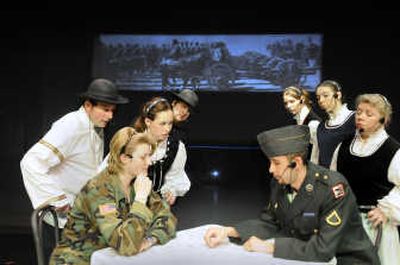Struggle Stage

“The Friendly Enemy,” which opens Tuesday at Spokane Community College, is an original musical that tells an epic story of firing squads, Russian POW camps and refugee camps. It is the true story of Post Falls couple Barbara Ohler Weber and Mike Weber, and making it into an original musical was an epic story of its own.
It began simply enough when retired Coeur d’Alene social worker Gary Edwards met the Webers at an ice cream social and heard some of Mike’s tales about being a soldier during World War II. Edwards asked a simple question, “For which side?” and the answer propelled him toward what would eventually become “The Friendly Enemy.”
“I was mostly interested in Mike’s story for fighting in the war from the enemy’s perspective,” said Edwards. Mike was drafted into the Hungarian Army, which was absorbed by the German Army.
Edwards spent two years researching and writing it. First he wrote it as a play. Then he decided to use his expertise as a composer – he’s a former Spokane Symphony musician who has written pieces for the Coeur d’Alene Symphony – to turn it into an opera.
In its first incarnation, “The Friendly Enemy” consisted of 43 songs, sung straight through. Then Edwards met Hershell Norwood, the director of the Spokane Community College Players, who was also fascinated by the story.
“The biggest challenge was to condense it to the stage,” said Norwood.
Norwood examined it with the eye of a director, and convinced Edwards to reduce the number of songs to 23 and to add dialogue to move the story along. Norwood, also a playwright, contributed the added dialogue.
The result will have its premiere Tuesday at SCC. “The Friendly Enemy” has 18 characters, including the main characters of Barbara, played by Jillian Wylie; and Mike, played by Nick Goodwin. A five-piece combo will provide the music.
The musical styles vary widely, reflecting Edwards’ background in classical music, rock music and just about everything in between. Because the first act is set in the Transylvanian village of Tschippendorf, it has a lot of Eastern European folk styles.
“Then there are classical elements, and even some rock and pop,” said Edwards. “One tune is a boogie-woogie number from the ‘40s. And I tried to fashion the band to sound like a Gypsy band.”
Edwards said he attempts to explore the following question in the show: “How could you fight for this cause that we perceived to be evil?”
The answer is, in many ways, the story of the war itself.
“All of the authorities said to just do what you’re told,” said Edwards. “Do your patriotic duty.”
The story itself, based on Barbara Ohler Weber’s self-published book, “Fleeing to the Enemy,” breaks down into two distinct sections. The first act is lighthearted and deals with Mike and Barbara’s courtship in their village of Tschippendorf, which is now part of Romania. That act ends when they get married.
“We already went to a part of a rehearsal and I said, ‘Oh, boy, does that bring back memories,’ ” said Barbara.
The second act is considerably darker. It chronicles the forces of war that caused them to be separated for most of the next eight years. Mike was drafted into the Hungarian Army and served as a border guard, where he was injured. Then the Hungarian Army became part of the German war machine and Mike spent years fighting Czech partisans.
Meanwhile, the war reached Tschippendorf. Barbara and her baby girl were ordered to evacuate by the Germans. They fled the only village they had ever known, by horse-drawn wagon. Eventually, they ended up in an Austrian refugee camp.
Meanwhile, Mike had been captured by Czech partisans. They lined their prisoners against a wall and shot every second one. Mike was one of the lucky ones. He escaped and was soon captured by the Americans, who then turned him over to the Russians. He ended up in a Russian prison camp near the Caspian Sea, where he remained for years.
They were finally reunited in 1948, when Mike, weighing 90 pounds, was released.
That’s where the musical ends, but Mike and Barbara’s story continues as they emigrated to the U.S. in 1952, grew apples in Wenatchee, raised seven children and eventually moved to Post Falls. They are planning a family reunion around the musical, attended by six of their children.
Edwards said he had two musical role models in mind in crafting this show, both dealing with large political forces: “Les Miserables” and “Evita.”
Norwood said the show reminds him of “Fiddler on the Roof,” with its Eastern European flavor.
Barbara Ohler Weber said she’s not sure that any stage show – or even any movie – can fully depict the trauma of fleeing a village in a horse-drawn wagon in the midst of war. But with enough imagination, audiences at the Lair may get an inkling of what the Webers lived through during those momentous times.